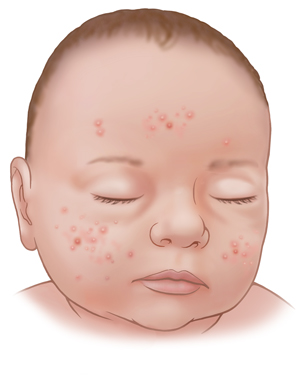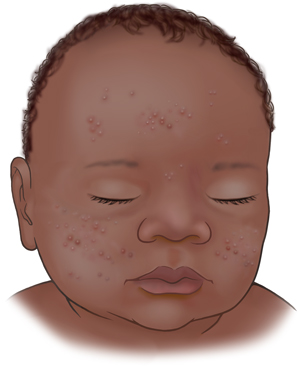Baby Acne (Neonatal Acne)
Baby acne (neonatal acne) is a skin condition that affects about 2 out of 10 newborns. It occurs when a baby is about 2 to 6 weeks old. Infants with baby acne have small red or white bumps on their face.
What causes baby acne?
Health experts aren’t exactly sure what causes baby acne. It’s thought to be from hormones that are passed from the birthing parent to the baby during pregnancy.
What are the symptoms of baby acne?
Infants with baby acne have small red or white bumps on their cheeks, chin, forehead, or nose. Some newborns may also have acne on their neck and upper chest. Baby acne often clears up on its own and generally doesn’t leave any scarring.


Acne in older babies
Baby acne is different from acne that occurs in older infants. If acne first appears after your newborn is 6 weeks old, talk to their healthcare provider. This may be a less common condition called infantile acne. Infantile acne lasts longer than baby acne. It can last from a few months up to 2 years. It may be linked to other problems. It may need treatment to prevent scarring.
How is baby acne treated?
In most cases, baby acne clears up on its own. Treatment is often not needed. But if your newborn has a lot of pimples, or if the pimples last for a few months, talk to their healthcare provider. In some cases, they may prescribe a medicated cream or lotion.
Follow the provider’s advice on how to care for your baby’s skin while they have acne. In general, follow these tips:
-
Wipe your baby’s skin gently with lukewarm water, then gently pat it dry. Never use hot water on your newborn’s skin.
-
Don’t use soap or lotion on the affected area.
-
Don’t scrub or scratch the pimples.
-
Don’t use acne medicine on your baby’s skin, unless the provider advises you to.
-
Don’t use oily skin care products on your baby.
When to call your child's healthcare provider
Call the healthcare provider if your baby:
-
Has a rash with a fever (see Fever and children below).
-
Has small red or white bumps on their face in the first few weeks after birth.
-
Has baby acne that doesn’t go away after a few months.
-
Has acne that first appears after 6 weeks old. This may be a different, longer-lasting condition called infantile acne.
Fever and children
Use a digital thermometer to check your child’s temperature. Don’t use a mercury thermometer. There are different kinds and uses of digital thermometers. They include:
-
Rectal. For children younger than 3 years, a rectal temperature is the most accurate.
-
Forehead (temporal). This works for children age 3 months and older. If a child under 3 months old has signs of illness, this can be used for a first pass. The provider may want to confirm with a rectal temperature.
-
Ear (tympanic). Ear temperatures are accurate after 6 months of age, but not before.
-
Armpit (axillary). This is the least reliable but may be used for a first pass to check a child of any age with signs of illness. The provider may want to confirm with a rectal temperature.
-
Mouth (oral). Don’t use a thermometer in your child’s mouth until he or she is at least 4 years old.
Use the rectal thermometer with care. Follow the product maker’s directions for correct use. Insert it gently. Label it and make sure it’s not used in the mouth. It may pass on germs from the stool. If you don’t feel OK using a rectal thermometer, ask the healthcare provider what type to use instead. When you talk with any healthcare provider about your child’s fever, tell him or her which type you used.
Below are guidelines for when to call the doctor if your child has a fever. Your child’s healthcare provider may give you different numbers for your child. Follow your provider’s specific instructions.
Fever readings for a baby under 3 months old:
-
First, ask your child’s healthcare provider how you should take the temperature.
-
Rectal or forehead: 100.4°F (38°C) or higher
-
Armpit: 99°F (37.2°C) or higher
Fever readings for a child age 3 months to 36 months (3 years):
-
Rectal, forehead, or ear: 102°F (38.9°C) or higher
-
Armpit: 101°F (38.3°C) or higher
Call the healthcare provider in these cases:
-
Repeated temperature of 104°F (40°C) or higher in a child of any age
-
Fever of 100.4°F (38°C) or higher in baby younger than 3 months
-
Fever that lasts more than 24 hours in a child under age 2
-
Fever that lasts for 3 days in a child age 2 or older
Also call your child's doctor right away if your child has a fever and:
-
Has been in a very hot place, looks very sick or drowsy, has other symptoms, has problems with their immune system, or has heart disease or seizures.